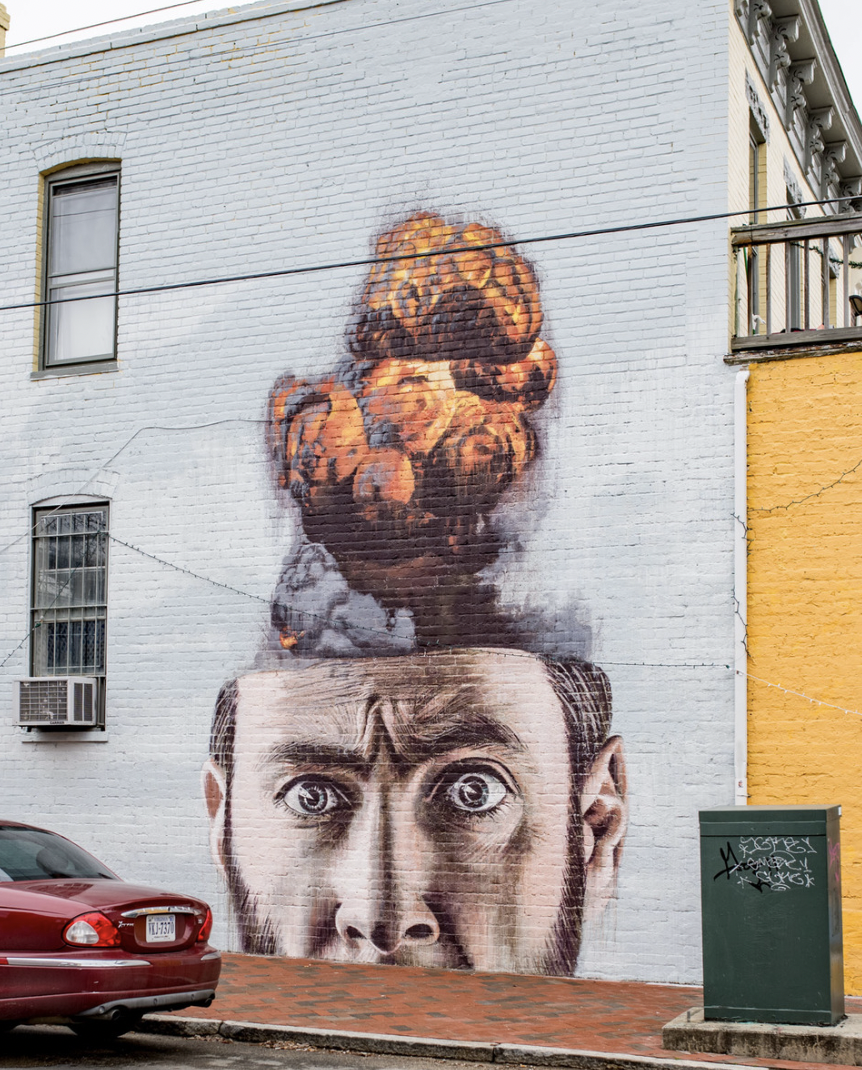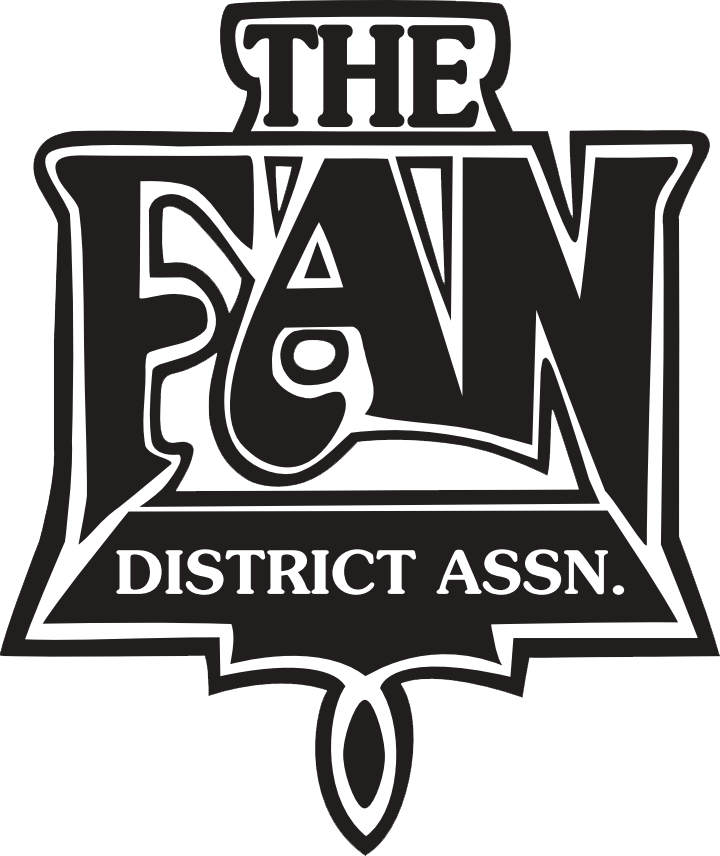
 Overthink Mural by Onur
Overthink Mural by Onur

This mural by artist, Onur, inspired local artists to create an interpretive chain of art work that celebrates their unique perspectives and invites you to ask yourself what would each link be if it were something else.
Artist
Location
 What do you See?
What do you See?


 Magnolia Consequencesong by Deau Eyes & Dusty Ray
Magnolia Consequencesong by Deau Eyes & Dusty Ray

Let’s hear from the artist:
“I’ve passed this mural in the neighborhood countless times and never stopped to witness it. Consuming so much, working tirelessly for what you believe in, zipping by to get to the next job, task, what-have-you is parallel to the events leading up to the catastrophic “event” illustrated in the work.
To stop and take it in is like a mirror of truth. Imagining this man’s past, present, future on a loop, I mourned over this impending doom and the wordless hook took shape. Then an army of tiny irrigators flushed through his head, collecting truths in the thick grit of a thousand generations; examining where new healthy growth is possible. I imagined an untouchable amount of infrastructure naturally exploding; our soft human bodies looking for answers from doctors with the same soft human bodies. Then there’s tiny AI robots sifting through the data in his brain, analyzing how we can program evolution out of the consequences of war impounded in a person over the course of so many years that it literally manifests itself out of this white-man’s brain. The topography of his face makes me feel like his nature was never built for this power; in this Magnolia Consequence he’s just as confused as we are.
In the spirit of the prompt, I created a very simple melody and a raw expression of what I saw in the mural. Having no idea this piece was called “Doom Loop”- I started with my own mourning/ doom-like loop. The memory of an explosion beneath a funeral, a commemoration of life and a welcoming of death, opening new doors to the future. The premonition of war and mothers singing their children to sleep is really what the mural was giving to me.
I sent a draft of this stream-of-consciousness song to my good friend Dusty Ray and he expanded on the project, capturing the unspoken story with sounds. It’s pretty special that his work was so aligned with the unspoken inner workings of the story I wrote. He’d sent me a Portishead track before he started and it was spot on “the vibe”
We start with this plea, a mantra amidst eerie darkness, like navigating your way out of those clouds of smoke as a foreshadowing of the “event”
That same mantra is used later, cut in half, to provoke tension/ anxiety before coming back home to our doom-loop hook. Like being wrapped in a blanket in the aftermath. Dusty created these beautiful melodies that sound like magnolias flowering over the course of time. Like a time-capsule of everything that once was and someday will be beautiful.”
Artist
Location
 What do you Hear?
What do you Hear?


 Cognac Melodyice cream flavor by Jody Spraker-Pozen
Cognac Melodyice cream flavor by Jody Spraker-Pozen

Cognac ice cream with smoked sea salt chocolate, toasted pepitas and chewy caramel swirl.
Let’s hear from the artist:
“As the piano began, I envisioned rain tapping on a window; the droplets clinging to the glass, then converging, and trickling down in little streams. Then we hear this melancholy, almost mournful voice singing “when all of it’s burned up, down with the construct, these flowering seeds ain’t gonna need me.” Is it grief in her voice? Defiance? Acceptance? It made my mind wander and think about which “constructs” should come down, and which “seeds” – literally and figuratively – should grow and flourish. Every time I listened to the song, I heard something new or thought about it in a different way.
The ice cream is spiked with a little Cognac, which provides a similarly moody and mysterious backdrop. I interpreted the streaming rain into ripples of toasty, sweet caramel. The smoked sea salt chocolate echoes the “burned up” lyric and the “flowering seeds” became pepitas (pumpkin seeds); both of which contrast with the sweeter elements in the ice cream, like the contrast I felt between the major and minor chords in the song. I also wanted to challenge the common assumption (or construct) that ice cream is simply sweet, by balancing it with the salty, smoky, and bitter flavors in the other ingredients. Just as I kept listening to the song and thinking about it in new ways, I hope each bite of the ice cream will taste slightly different than the last, creating a melody of flavors that you keep coming back for.”
Artist
Location
 What do you Taste?
What do you Taste?


 Summers Endphotograph by Riley Goodman
Summers Endphotograph by Riley Goodman

Let’s hear from the artist:
“I was so pleasantly surprised when I found out the art I’d be interpreting was an ice cream flavor. As a visual artist I admittedly sometimes forget to see culinary endeavors as a branch of an artistic practice, so I was excited to be reminded of just how much food can be art. This flavor felt like it was tailor made to me- combining the sweet and savory aspects of ice cream that I love. Sunflowers have such a distinct taste and place in one’s vision of summer- when paired with caramel and chocolate it created for me the perfect summation of my experience of Richmond summers.
As previously mentioned, sunflowers have such a distinct place in my vision of summer. I have grown them from seed in my front yard for the past two years. This element of the ice cream flavor really inspired me to create my photographic reaction- a visual interpretation of the nostalgia that comes at the end of the summer. Combining ephemera and objects I’ve collected over the years, alongside seeds I’ve collected from the sunflowers I’ve grown myself, Summer’s End depicts a figurative and literal box of memories- items that together paint a portrait of an unknown owner, their meaning left up to interpretation by the viewer, but their importance undeniable. I wanted to showcase a sense of warmth, but also a sense of impermanence, much like the lifespan of ice cream and summer itself.”
Artist
Location
 What do you See?
What do you See?


 A Cigar Boxpoem by Addie Eliades
A Cigar Boxpoem by Addie Eliades

Let’s hear from the artist:
“I understood the photo I received to depict a sort of excavated time capsule, a portal into a unique piece of the past. The contents of the box — personal memories, special artifacts and cultural relics — have universal significances and purposes, but those beyond the obvious raised questions in me I ultimately kept suspended. Rather than parse out what particular function or resonance each item had in its past life, I interpreted the photo’s significance, generally, through the idea of ambiguity. The sheer sense of wonder — upon unpacking a variety of dated objects, untethered from context and collected into a specific, mysterious curation — was the engine for my poem.
Being that my medium is words, one method that has worked for my poetry is brainstorming all words, terms, phrases, expressions and ideas associated with a subject and then arranging, stylizing and revising the most promising ones into a proper poem. The visual anchor of the photo I inherited and its richness in detail lent me a reservoir of words and phrases from which to select and with which to compose my response. I recursively listed and mused on the objective details of the photo and their more subjective associations. My goal with ekphrastic responses like this one is always to somehow invigorate or complicate the visual. That being said, I decided that the “telephonic” concept behind the Consenses Walk project — taking a week to think on and create based on a previous creator’s interpretation, then passing your interpretation on to the next creative respondent — merited maintaining most of the photo’s integrity in my poem, as opposed to filtering it through too dynamic of an interpretation. This approach also reflects my celebration of the photo’s “particular ambiguity” via descriptive-meditative writing. I hope that my more objective writing extends the legacy of the project at-large while my more subjective writing enhances the conversation in some refreshing way.”
Artist
Location
 What do you See?
What do you See?


 Corner Boxsculpture by Morgan Gilbreath
Corner Boxsculpture by Morgan Gilbreath

Let’s hear from the artist:
“The poem described an old cigar box stashed in the corner of the home, filled with odds and ends. Every individual item in the box was lovingly described in detail, even down to the smell. It made me think about items in our home that we immortalize. I thought about the cigar box as a vessel to contain cherished objects and the memories associated with them. Even if their function is long gone, we cannot bear to get rid of them quite yet (whether for emotional or practical reasons).
I think of the cigar box as space for these items which are on the edge of existing – cherished and hoarded, but not actively used or acknowledged.
When I read this poem, I thought about the act of consolidating small pieces or particles together into a contained space that is safe and out of the way. For some reason, I thought of accumulation and sweeping things into a corner. (a corner being an unused space similar to a discarded cigar box)
My reaction piece is a glass pyramid form filled with the swept up dust and debris from the floor of my home and studio. The vitrine form is intended to be displayed in the corner of a room on the ground, as if . The dust looks gray and nondescript, but upon closer inspection a world emerges within the pieces of my life and home: leaves, skin, pollen, hair, crumbs, cat fur, nails, lint, a pine needle, a whisker, onion skin, bits of string, plastic tabs, a live ant, salt, plaster, dirt, etc. The closer you look the more you see. Similar to the poem, I intended for my sculpture to immortalize the small objects on the periphery of our existence that we rarely notice.”
Artist
Location
 What do you See?
What do you See?

Interpretations
I hear the longing of youth to be grown up and the longing of the old to be young again. I hear the ache of sunburn and the relief of the shade. I hear eyes newly exposed to the light and the desire to rest. The desire to sleep.
Sally Taylor






